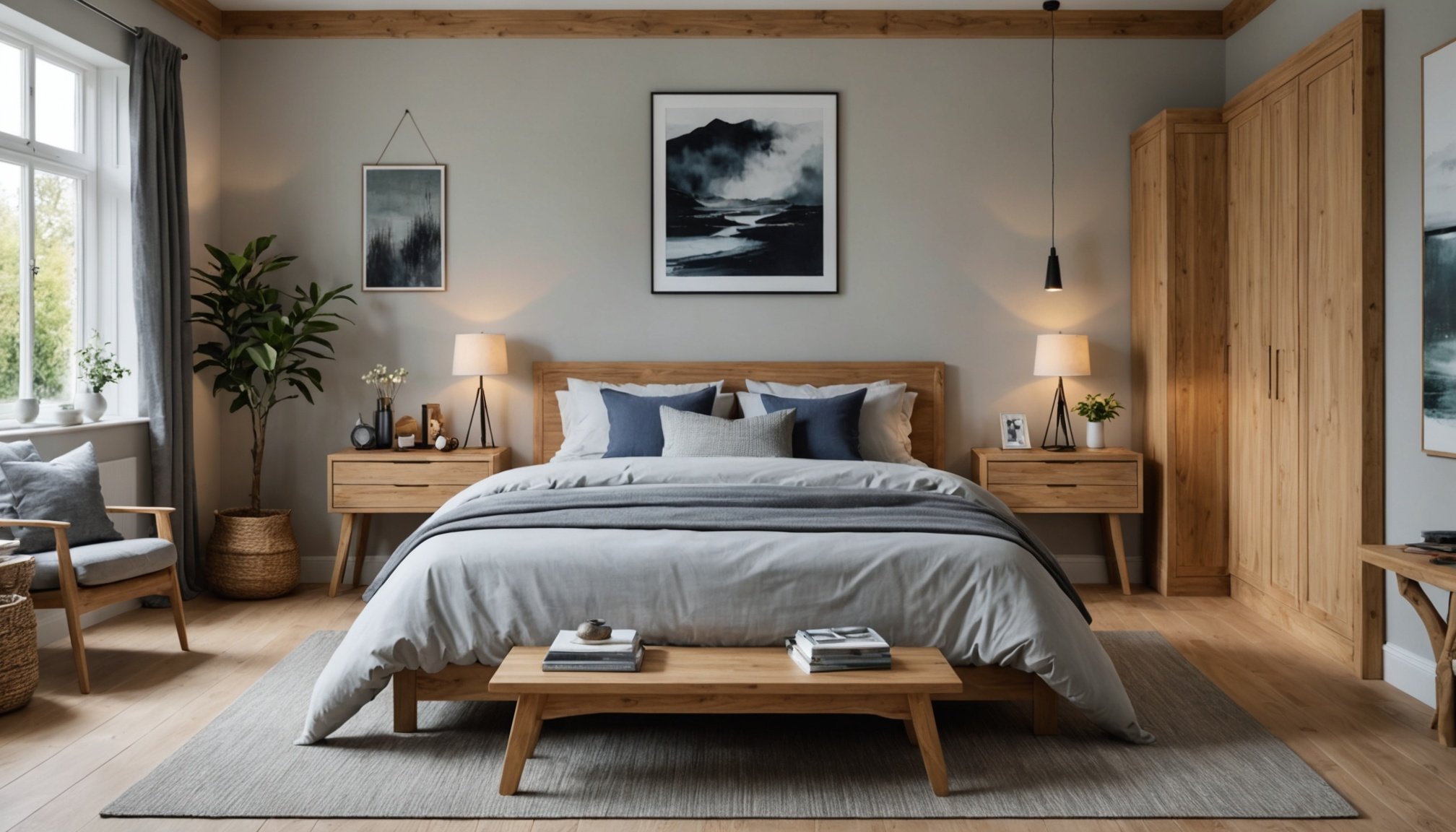Essential Color Schemes for a Zen Bedroom
Creating a zen-like atmosphere in your bedroom starts with choosing the right calming color palettes. These schemes can profoundly influence the mood and vibe of the space, making it a serene retreat from daily stresses. Neutral tones such as soft greys, beiges, and off-whites are ideal for promoting relaxation. These hues act as a blank canvas, allowing other elements in the room to shine without overwhelming the senses.
Integrating soft hues like muted greens or pale blues can further enhance the tranquil feel of your bedroom. These colors are reminiscent of nature and help calm the mind. Pair these with natural materials and textures to create a cohesive, relaxing environment.
Avez-vous vu cela : Essential Components for Crafting a Genuine Coastal Bathroom Inspired by the UK
A significant aspect to consider is the impact of natural light on your chosen color palettes. Light can drastically alter how a color appears in a room, making it either more vibrant or subdued. For spaces that receive ample natural light, cooler tones can be accentuated, whereas areas with less light may benefit from warmer shades to prevent the room from feeling cold or uninviting.
Ultimately, thoughtfully selected colors can create a sanctuary that promotes comfort and peace, making the bedroom a perfect place to unwind.
A lire en complément : Enchant your bookshelf with stunning book nook creations
Furniture Choices that Enhance Serenity
To create a soothing home environment, selecting the right minimalist furniture is essential. Characteristics of zen-inspired furniture often include simple lines, uncluttered spaces, and a focus on natural materials like wood, stone, or bamboo. These materials not only bring a touch of nature indoors but also contribute to a calm atmosphere, devoid of unnecessary distractions.
When choosing pieces that foster calmness, consider furniture with a functional design. Think of furniture items that serve a purpose yet maintain a sleek, understated appearance. For example, a wooden bench with storage underneath is both practical and aesthetically pleasing.
In smaller living spaces, multifunctional furniture is particularly beneficial. Opt for items like a coffee table that doubles as a desk or a sofa bed that can easily transform from seating to sleeping arrangements. These clever furniture pieces help maximize limited areas without compromising on the minimalist aesthetic of serenity.
By prioritizing minimalist furniture crafted from natural materials and featuring a functional design, you can cultivate a tranquil atmosphere in any space. This thoughtful approach ensures a harmonious balance between practicality and aesthetics, allowing you to enjoy a peaceful retreat within your home.
Incorporating Natural Elements
Infusing your space with indoor plants not only enhances aesthetics but also significantly boosts air quality. Certain plants, like the snake plant and peace lily, thrive indoors and effectively filter toxins from the air, fostering a healthier living environment. You’ll find these green companions easy to care for, as they adapt well to indoor conditions and require minimal maintenance.
Aside from plants, embracing natural textures and organic materials can dramatically transform your surroundings. Incorporating elements such as wood, stone, and woven fabrics in your decor brings a sense of earthiness and warmth to your home. Imagine a wooden headboard paired with stone accents or a jute rug—they all invite the serenity of nature into your living space. Such materials not only create a visual appeal but also provide a tactile experience that enriches the senses.
Creating a connection with nature in the bedroom doesn’t stop with merely adding these elements. It’s about curating an environment where nature subtly integrates into daily life. Position your indoor plants strategically to utilize sunlight, and use natural textures to complement the overall ambiance. By doing so, you form a calming retreat that resonates with the rejuvenating essence of the outdoors.
Mindfulness Through Organization
Creating a harmonious living environment often begins with decluttering techniques. Start by sorting items into categories: keep, donate, or discard. This simple method not only reduces clutter but also creates a foundation for a more minimalist design. Embracing minimalism doesn’t mean sacrificing all possessions; it means valuing items that bring joy and utility.
Storage solutions play a pivotal role in maintaining an organized space. Think of multi-functional furniture like ottomans with hidden compartments or beds with built-in drawers. These clever solutions effectively maximize space while keeping items accessible. Choosing open shelving or modular units also encourages an organized, tidy layout that highlights essential items without overcrowding.
Minimalist design is more than aesthetic; it’s a lifestyle choice. By integrating fewer items, your environment can promote mental clarity and relaxation. A tidy space minimizes distractions, allowing focus on daily tasks and nurturing a mindful mindset. Consider the psychological impact: a clear environment can often translate to a clear mind.
Strategies like these not only simplify spaces but also promote sustainable living and mindfulness. By consciously organizing and designing your environment, you’ll notice improvements in not just physical surroundings but also mental well-being. Embracing these concepts ultimately paves the way for a balanced, mindful living space.
Decor Elements for a Calming Atmosphere
Creating a calming atmosphere begins with Zen decor and essential pieces that embody simplicity and balance. These elements include minimalist art, natural materials like bamboo, and serene colour palettes to evoke peace. Integrating such decor influences tranquillity in any space.
Incorporating calming accessories is key to enhancing relaxation at home. Consider adding soft textures like plush cushions or woollen throws to infuse comfort. Rugs with subtle patterns can break the monotony while still maintaining the Zen vibe.
Sensory elements, such as lighting and scents, play a significant role in establishing a peaceful environment. Opt for warm, dim lighting to create a soothing ambience. Scented candles or essential oils, with aromas like lavender or eucalyptus, can stimulate the senses and promote calmness. This engaging mix encourages a sensory experience that aligns with the principles of Zen decor.
Balancing decoration with minimalism ensures a space does not feel cluttered. It involves selecting functional yet decorative items that serve a dual purpose. For instance:
- Compact storage solutions for tidiness
- Simple centrepieces like a single flower in a vase
- Open shelving to display meaningful objects without overcrowding
Through the careful selection of each piece, you achieve a harmonious blend, enveloping your space in serenity.
Practical Advice for UK Homes
When embracing Zen principles in UK decor trends, it’s essential to consider typical UK home sizes and layouts. Many UK homes, especially older ones, often have smaller rooms and limited space. To accommodate Zen design, which thrives on minimalism and openness, one might need to creatively manage these spatial constraints. Clever storage solutions and multi-functional furniture can help transform small areas into serene spaces.
Sourcing materials locally is crucial for authentically incorporating Zen into UK decor trends. Using local resources reduces the environmental impact and can offer unique textures and finishes that enhance the natural feel essential to Zen aesthetics. Consider sourcing UK wood and stones that harmonise with a Zen style while paying homage to the local environment.
Adapting Zen principles to fit the UK’s climate requires thoughtful selection of materials and design elements. The UK’s often damp weather calls for materials that can withstand humidity and provide warmth, like wool or heavy cottons. Furthermore, integrating elements that invite natural light can be beneficial in maximising the gentle, calming effect Zen aims to achieve. By aligning with UK decor trends and choosing sustainable, local materials, homeowners can create tranquil, Zen-inspired spaces within the practical realities of UK living environments.
Visual Inspiration and Product Recommendations
Creating a zen-inspired bedroom retreat begins with a thoughtfully curated mood board. This essential tool helps you envision your ideal space by collecting images, textures, and colours that evoke tranquillity. Begin with neutral tones and earthy textures to capture the essence of zen philosophy. Consider adding calming imagery such as serene landscapes or minimalist art pieces.
For those in search of interior design tips that align with zen aesthetics, several renowned brands offer products that can enhance your space. Look for understated furniture from companies like Muji and West Elm, known for their clean lines and natural materials. Soft lighting options, such as salt lamps or rice paper lamps, create a soothing atmosphere while maintaining visual simplicity.
When seeking inspiration, utilize both physical and digital resources. Design books focusing on minimalist or Asian-inspired decor provide rich visual guidance. Websites like Pinterest and Instagram allow you to explore various zen-influenced settings, with countless ideas for your mood board. Follow hashtags like #ZenInteriors or #MinimalistDecor to discover new perspectives.
Incorporating zen-inspired products into your home doesn’t just improve aesthetics; it also contributes to a more peaceful and balanced environment. Remember that every item you choose should serve a purpose, aligning with the zen principle of simplicity and mindfulness.











